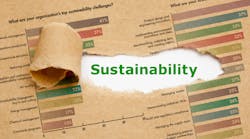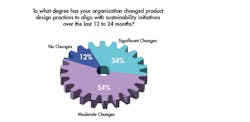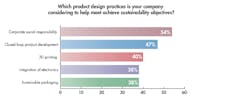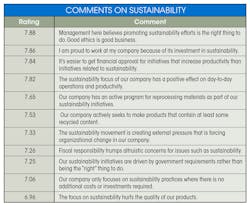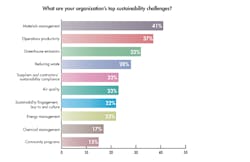Managers at Protolabs, a company that offers manufacturing services such as 3D printing, CNC machining and injection molding to designers and manufacturing firms, were curious about what the companies were doing with their sustainability initiatives.
To find out, the company commissioned EGL ACE Research to do an online survey of executives, sustainability leaders and product developers across the medical, automotive and aerospace industries. The goal was to uncover what they and their companies are doing to succeed at sustainability, how product design is affected and how manufacturing can help meet sustainability goals.
They received replies from 200 people, 50 of whom were company executives, 50 were sustainability managers and professionals, and 100 were product designers and engineers. 75% of the respondents were between 36 and 55 years old, with 60% at least 46 years old. 90% worked at companies with at least 100 employees and 30% worked in firms with 1,000 or more employees.
Most respondent had significant exposure to the concept of sustainability. 68% had been involved with the concept for at least six years and 21% have been working with it for 11 years or more.
Defining Sustainability
It would seem that most engineers include several aspects of sustainability when doing their jobs. They look for the least expensive methods and materials to accomplish a task or build a product. They strive to reduce scrap and not waste energy. They also adhere to environmental regulations.
“Engineers are focused on efficiency in their work,” says Paige Marie-Morse, a sustainability manager at AspenTech, a firm that assists companies in monitoring and managing assets. Its asset management software helps organizations streamline engineering and maintenance to reduce downtime and increase operational efficiencies. “But at AspenTech, we align our definition of sustainability with the United Nations Brundtland Commission. It defines sustainability as ‘meeting the needs of the present without compromising the ability of future generations to meet their own needs.’”
“What has changed for engineers are the metrics used to evaluate projects and designs. Industrial organizations have broadened their performance metrics beyond only financial performance and ROI in product design to increasingly account for environmental metrics such as emissions and waste reduction, and the impact of manufacturing processes on local communities. It’s the balancing of these factors, as well as tracking less obvious measures, that makes efforts toward sustainability more challenging.”
The Results
For most, their organization’s involvement with sustainability were based more with an eye on the bottom line and improving the company’s reputation than on a commitment to any idealistic goals.
Regardless of why they support sustainability, most companies did make changes in product design in response to it.
According to the survey, respondents say 88% of companies have made changes in product design and sustainability in the last two years. So, it seems companies are doing a lot to achieve sustainability in product design.
The survey also indicates that sustainability initiatives have positive momentum among product design and engineering companies.
Respondents were then asked which product design/development areas in their company would benefit most by implementing sustainability initiatives. 51% said materials engineering and 50% said sourcing and procurement.
They were also asked how confident they were that employees understood and could recite how company sustainability initiatives align with the overall company strategy. On a scale of 1 to 10, with 10 being very confident, executives and sustainability professional said 8. Product designers and engineers came in a little lower at 7.
When asked how confident they were that company investments in sustainability will lead to significant value, revenue gains, cost savings and enterprise value, answers were similar. Executives and sustainability professionals said 8, while engineers and product development designers rate their confidence a 7.
Here are some comments on this survey question from respondents arranged according to their ratings.
So, according to the survey results, those responsible for setting sustainability strategies are more confident about its implementation being successful than those responsible for implementing it.
Those setting and carrying out sustainability strategy also have a list of top priorities.
Respondents indicate that sustainable materials management is expected to be the top challenge today and into the future. Overall, companies expect to be working toward these same goals two years from now.
Sustainability seems to be such a broad umbrella that it is taking up a large percentage of employees’ time. As the table below shows, respondents say they are working on a variety of sustainability initiatives.
There are a lot of initiatives competing for organizational time and resources, which could divert the company’s focus from more profitable pursuits.
For a copy of the report, click here.
